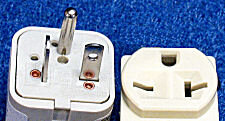The plug we use is the NEMA 6-15 or 6-20 plug. That is the standard single phase 220v-250v, male 15 amp plug or the 20 amp plug. This plug is exactly the same size as a 110v-120v plug but the hot wires are horizontal on the 220v instead of vertical as on the 110v-120v plug. You do not need a 50 amp dryer plug for a compressor that draws 12.7 amps or less running.
That is a very common outlet here in America and if you have a special need just let me know prior to the sale and we will help you with it.
The other manufacturors do not put a plug on there at all. We include the plug, on / off switch, hour meter and cord at no charge and we will put pretty much any plug you want on there if you just tell us what you want.
Most of the confusion was in one of the original posts there was a picture of some foreign plug and definatly NOT what we use. look up NEMA 6-15 plug and I may try to post a picture of one tommorow. Most of you have one of those plugs in your garages already.
Bruce
Thanks for the answer, Bruce! Sorry I am new to all of this stuff.
I was unable to find a photo of the appropriate NEMA plug on the Internet, hence the next best thing was the photo in my OP.
I addressed my question about the plug to "technical support" at AireTex. Did I get a compressor meant for Europe? No, AireTex told me they installed the NEMA plug in Texas for the USA market.
My next question was: "Where in the USA is this plug commonly used? Is the outlet common in industrial or commercial settings? Is this something that a dive shop would be able to just "plug and play" in a commercial space?"
The answer was, "no," they couldn't think of anywhere this plug is commonly found. You had to install a NEMA outlet or get an adapter to use it in your dryer outlet.
My next question was, "If you're going through all the trouble to install a plug, why not install a plug that everyone can use right out of the box?"
You see, I don't know anyone who has a NEMA 6-15 or 6-20 outlet readily available in their home, but I know that just about everyone has a regular ol' dryer outlet ready to go.
I understand the part about the 15-amp versus the 50-amp outlet. Makes sense now that you explain it. But if you're going through all the trouble to install a plug, why not install a plug that everyone can use right out of the box without buying adapter or installing a new outlet? Do most people install a new circuit breaker in their electrical box and run wires to their garage to install a 15-amp NEMA outlet?
I've got my compressor up and running now, so it's just curiosity now.
Thank you.





